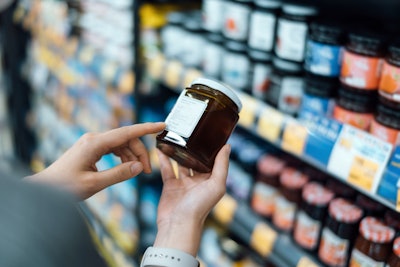The push for sustainable packaging is felt along the entire CPG supply chain with retailers, brand owners, and material suppliers all feeling the pressure from consumers to reduce packaging waste and create a more sustainable package than ever before.
When it comes to marketing their sustainable package, brands often call out key attributes or make vague sustainability claims on pack. The problem often is that what the company thinks its green claims mean and what consumers understand them to mean can be two different things. This is where unwitting “greenwashing” may come into play.
Greenwashing in consumer-packaged goods packaging manifests in several ways, often intentionally exploiting ambiguity and the consumer desire for sustainability, along with consumer ignorance. Most often, greenwashing shows up in the form of vague or irrelevant text or even misleading imagery, but sometimes it can appear to be more deceptive.
Greenwashing isn’t a new concept, and you’ve likely seen that groups, states, and even countries continue to crack down on brands that appear to be intentionally engaging in greenwashing. But how do you know if you are greenwashing unintentionally? And what are the consequences of unintentional greenwashing?
False Claims and Bad PR
Some vague environmental claims on packaging can seem innocent enough, but they can end up causing a lot of trouble. While none of the companies mentioned here have admitted to any wrongdoing, greenwashing accusations still resulted in a class action lawsuit with big payouts.
A 2018 class action lawsuit alleged that Keurig engaged in “unlawful, unfair, and deceptive business practices” when the company advertised and labeled its K-Cups as recyclable. The problem was, most regional recycling facilities weren't able to process the K-Cups due to either their material classification or small size, meaning the cups were not, effectively, recyclable, the lawsuit alleged. In February 2022, Keurig agreed to a $10 million settlement.
Also due to false recycling claims, in 2023, Reynolds Consumer Products was put under scrutiny for claiming that its Hefty and Great Value brands’ recycling trash bags were recyclable when they were not.
Plaintiffs allege that Reynolds's use of the claim "recycling" on the packaging of its recycling trash bags was misleading because "recycling" trash bags are not recyclable at many solid waste disposal facilities and are not suitable for the disposal of recyclable products at these facilities. Reynolds has agreed to pay up to $3 million to settle the claims, as well as reformulate the bags to make them recyclable or remove those claims from packaging.
Then there’s the ongoing lawsuit against Colgate-Palmolive for its “breakthrough” recyclable toothpaste tube made of mono-material HDPE that the company says can be recycled alongside other No. 2 HDPE containers, such as detergent jugs. The package features the recycle symbol and bold lettering saying, “Recycle Me,” which led consumers to believe the tube to be widely accepted at recycling facilities. But the truth is that few facilities accept the tubes, and in fact, only a “miniscule number of consumers” in California and across the country can recycle the HDPE tubes.
It isn’t just CPG brands that may over-promise and under-deliver on sustainability claims. George Koutsimanis, a packaging engineer at Kent Precision Foods Group shared that he sees greenwashing happening from material suppliers too.
“In the past we have seen several companies trying to sell packaging material claiming their films are biodegradable, or photodegradable or… more friendly to marine life because the fibers will degrade and fall apart and … break into small pieces and not harm the wildlife. But it was hard to validate these claims,” said Koutsimanis.
Without sufficient support to back up environmental claims like these, brands are at risk of greenwashing. The remedy to this is more standards with clear guidelines that companies can adhere to.
Green Guides
To help brands (specifically the marketing team) avoid making environmental claims that mislead consumers, the FTC (Federal Trade Commission) maintains its Green Guides.
According to the FTC, “The Green Guides were first issued in 1992 and were revised in 1996, 1998, and 2012. The guidance they provide includes: 1) general principles that apply to all environmental marketing claims; 2) how consumers are likely to interpret particular claims, and how marketers can substantiate these claims; and 3) how marketers can qualify their claims to avoid deceiving consumers.”
They work to standardize the common terminology on packaging so that companies and consumers understand the common, consistent messaging. The goal is to ensure that claims are relevant, factual, and honest.
The FTC began the process of once again updating the Green Guides by seeking public comment in December 2022 and again in early 2023. Unfortunately, there is no further word on where the FTC is in the process of updating the guides.
But diving into why the Green Guides exist and how they can help companies prevent greenwashing traps, I spoke to Eric Greenberg, a Principal Attorney at Eric F. Greenberg P.C., who helps clients comply with Green Guide standards. According to Greenberg, greenwashing is not a cut and dry offense. Sometimes companies are not trying to deceive consumers but simply don’t know that the FTC Green Guides exist.
“There’s probably less actual fraudulent greenwashing than people seem to think. There are fewer companies blatantly lying to the public,” said Greenberg. “The reality is that the package label may just be badly phrased or too vague.”
I spoke with Bob Lilienfeld, Executive Director, SPRING (Sustainable Packaging, Research, Information & Networking Group) about this topic and he further explained that part of the problem is the average consumer is uninformed when it comes to packaging sustainability.
“The guides are general, and the public doesn’t know what some of it means. Most consumers do not critically think about these types of claims,” said Lilienfeld.
Then there is the issue of trying to define broad terms like “sustainable” and “eco-friendly”— terms that likely have different meaning to different people. To that extent, Greenberg observes that the FTC has yet to come up with a clear definition of the term “sustainable.” In 2012, the FTC specifically refrained from issuing guidance for how to use the term “sustainable.” The agency thought, based on evidence of consumer perceptions, that “the claim has no single meaning to a significant number of consumers,” and to some it conveys nonenvironmental characteristics, such as that the product is durable.
“It’s tough to qualify the term ‘sustainable.’ And up until now, the FTC has not been prepared to create a definition for [it],” said Greenberg.
There are other terms causing confusion, as well.
For example, right now, for a package to be considered recyclable, the FTC states that 60% of people must have easy access (whether curbside or local recycling center availability) to a recycling program that recovers the item and diverts it for reuse.
Lilienfeld went on to say that when it comes to compostability, however, there is no set “rule” like that for recyclability, so the term “compostable” can be used regardless of consumer access to composting. (Unlike recycling infrastructure, there is currently no real municipal composting infrastructure in the U.S).
“There’s inconsistency [in the guide],” said Lilienfeld.
The Green Guides are just that, guides, and not set laws or rules that are consistently enforced. Though, of course, some claims are challenged, and a remedy is enforced, the FTC likely doesn’t have the resources to investigate each package claim made by millions of brands each year.
“The industry has become a free-for-all,” said Lilienfeld. “Big players know the rules. But small startups are making claims, intentionally or unintentionally. But no one is telling them not to.”
A Look at Recycling
A big part of greenwashing is using the claim “recyclable” when the package is not widely recycled (remember those lawsuits?) or whose components aren’t fully recyclable.
“If not all components of a package are recyclable, then technically the package is not recyclable. There are a lot of examples where a bottle is recyclable but not the closure. We want to steer clear of this kind of confusion for our current and future customers,” said Koutsimanis.
Then there is the recycling label. With so many different types of recycling labels with various instructions for proper recycling, it’s no wonder that consumers are confused.
At the Packaging Recycling Summit held in Atlanta, GA last November, Myles Cohen, previously president of both Pratt Recycling and Sonoco Recycling, and now the founder of Circular Ventures LLC, said that one of the biggest reasons MRFs (material recovery facilities) are often contaminated with non-recyclable products is consumer confusion.
“The responsibility, at least partially, is on the brands. They slap the recycling symbol on everything, and the consumer is so confused,” said Cohen in a recent interview.
A tongue-and-cheek example of consumer confusion over recycling is evident in this video from Ellen Degeneres. While it’s a bit extreme, the point is made clearly that recycling bin and label confusion doesn’t help anybody.
Back To Vague Language…
Across the pond, regulations surrounding greenwashing and making environmental claims on pack are stricter. As evidence, the European parliament is set to pass a new set of rules that aim to ban vague verbiage from products and services, including “environmentally friendly,” “eco-friendly,” “green,” “nature’s friend,” “climate friendly,” “gentle on the environment,” and “carbon friendly,” without proof of recognized excellent environmental performance relevant to the claim. These new regulations will require companies to show substantial evidence to back up any sustainability claims.
For example, the claim ‘climate-friendly packaging’ would be a generic claim, but if the brand claimed that ‘100% of energy used to produce this packaging comes from renewable sources,’ that would be a specific claim, which would not fall under this prohibition.
The agreement updates the existing EU list of banned commercial practices and adds to it several problematic marketing habits related to greenwashing and early obsolescence of goods. The aim of the new rules is to protect consumers from misleading practices and help them make better purchasing choices.
Defining greenwashing gets complicated when you factor in everything that goes into package development, recycling, and even marketing. Lilienfeld posed the question of a particular practice as an example of greenwashing, but it blurs the line.
“Companies will include a call out on the pack that declares the absence of a chemical or material that has never been in that makeup or formulation. Like, ‘BPA- free’. But there has never been BPA in that product. Is this greenwashing,” Lilienfeld asked rhetorically?
Company Pledges
On the other side of the greenwashing coin lies company goals, pledges, and public commitments. Companies across all sectors and of all sizes tend to make sustainability pledges, promising publicly that they will “reduce plastic usage by 50%,” “only use recycled materials by 2030,” or some other brand promise. An industry expert I spoke with, who wishes to be unnamed, shared with me that many times these pledges are nothing but empty promises.
“There’s no entity that holds any of these brands accountable for their pledges,” says the source.
Signaling a move away from the idea of pledges, Unilever took a step back from its lofty sustainability goals and chose to strip down its pledges for a more realistic approach. In an open letter on GreenBiz, Chairman and co-founder Joel Makower shared “why Unilever’s downshift on sustainability is good news.”
“Too many companies have committed to 2040 or 2050 goals without sufficient accountability as to what happens between now and then. Some of those long-term goals rely on technologies that are variously unproven, unreliable, or uneconomical, leading many activists to view them as anything from grandiose to greenwash,” wrote Makower in his letter.
At the end of 2023, Hein Schumacher, Unilever’s CEO, revealed in an investor call his company’s plan to refocus its sustainability goals to be less aspirational and more tangible. It’s a bold move at a time where brands are facing increased pressure from consumers and retailers to produce sustainable and recyclable packaging. But it’s a welcome reprieve from the company pledges that often promise big change well into the future. Unilever has long been revered for its corporate sustainability, but Schumacher’s plan to strip down its goals and focus on smaller, attainable ones is a move away from the brand’s Sustainable Living Plan, first laid out in 2010, that includes the 2017 commitment to 100% recyclable plastic packaging by 2025.
“The era when companies could make bold, audacious commitments without specifying how or when they’ll achieve them is ending,” said Makower.
It’s worth mentioning that other industries are shying way from bold sustainability pledges in a trend known as “greenhushing”. According to a recent Bloomberg article, JPMorgan Asset Management and State Global Advisors quit the world’s largest investor group formed to fight climate change.
According to the article, “over fears of political backlash, banks are hiding, rather than promoting their sustainability initiatives.”
Whether through pledges, vague on-pack language, or un-substantiated claims, greenwashing can appear even without malicious intent.
Are You Greenwashing?
Ok, so the moment of truth is here. Here are the top eight ways you may be greenwashing your packaging without intending to:
1. Vague claims: Terms like "natural," "eco-friendly," or "sustainable" are frequently used without clear definitions or specific details about environmental benefits.
2. Partial truths: Highlighting a single sustainable aspect (e.g., recycled paper) while ignoring unsustainable components (e.g., non-recyclable plastic closures) paints an incomplete picture.
3. Misleading imagery: Pictures of nature or green landscapes create an association with eco-friendliness even if the product itself has little environmental impact.
4. Certifications misdirection: Displaying obscure or generic sustainability certifications without explaining their criteria or verifying their legitimacy.
5. Irrelevant comparisons: Claims like "made with 20% less plastic" compared to an industry average that’s already high, downplaying the overall environmental impact.
6. Hidden trade-offs: Focusing on one positive attribute (e.g., organic ingredients) while ignoring less sustainable consequences (e.g., increased water usage or carbon footprint).
7. Shifting responsibility: Encouraging consumers to recycle packaging (despite limitations in infrastructure) while avoiding responsibility for designing easily recyclable options.
8. Greenwashing campaigns: Launching marketing campaigns emphasizing environmental initiatives while neglecting actual changes in packaging or production practices.
It’s clear that when it comes to greenwashing, whether intentional or not, standardized terminology and on-pack claims that are relevant, factual, and honest are necessary to mitigate consumer confusion.


























